|
|
KHAJURAHO
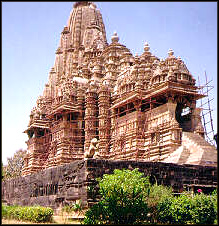  Close behind the Taj and up there with Varanasi, Jaipur
and Delhi, the temples of Khajuraho are one of India’s major
attractions. Once a great Chandela capital, Khajuraho is now just a quiet
village of just over 7000 people. In spite of all the tourist attention it’s
still a very mellow place to spend a few days. Close behind the Taj and up there with Varanasi, Jaipur
and Delhi, the temples of Khajuraho are one of India’s major
attractions. Once a great Chandela capital, Khajuraho is now just a quiet
village of just over 7000 people. In spite of all the tourist attention it’s
still a very mellow place to spend a few days.
The temples are superb examples of
Indo- Aryan architecture, but it’s the decorations with which they are
so liberally embellished that has made Khajuraho famous. Around the
temples are bands of exceedingly artistic stonework. The sculptors have
shown many
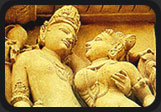 aspects of Indian life 1000 years ago- gods and goddesses,
warriors and musicians, real, and mythological animals. aspects of Indian life 1000 years ago- gods and goddesses,
warriors and musicians, real, and mythological animals.
But two elements appear
over and over again and in grater detail than anything else-women and sex.
Stone figures of apsaras, or celestial maidens, appear on every
temple. They pout and pose for all the world like pin-up models posing for
the camera. In between are the mithuna, erotic figures, running
through a whole Kamasutra of positions and possibilities.
Lakshmi & Varaha
Facing the large Lakshmana Temple are these two small shrines. The
Varaha Temple, dedicated to Vishnu’s boar incarnation or Varaha avatar,
faces the Matangesvara Temple. Inside this small, open shrine is a huge,
solid and intricately carved figure of the boar incarnation, dating from
around 900 AD.
Lakshmana :
The large
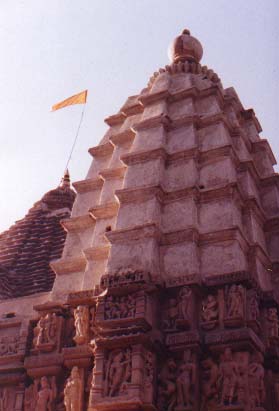 Lakshmana Temple is dedicated to Vishnu, although in
design it is similar to the Kandariya Mahadev and Vishvanath temples. It
is one of the earliest of the western enclosure temples, dating from
around 930 to 950 AD, and is also one of the best preserved, with a full
five-part floor plan and four subsidiary shrines. Around the temple are
two bands of sculpture instead of the usual three; the lower one has fine
figures of apsaras and some erotic scenes. Inside are excellent examples
of apsaras acting are supporting brackets. Lakshmana Temple is dedicated to Vishnu, although in
design it is similar to the Kandariya Mahadev and Vishvanath temples. It
is one of the earliest of the western enclosure temples, dating from
around 930 to 950 AD, and is also one of the best preserved, with a full
five-part floor plan and four subsidiary shrines. Around the temple are
two bands of sculpture instead of the usual three; the lower one has fine
figures of apsaras and some erotic scenes. Inside are excellent examples
of apsaras acting are supporting brackets.
On the subsidiary shrine at the south-west
corner is an architect working with his students- it is thought this may
be the temple’s designer including himself in the grand plan. Around the
base of the temple is a continuous frieze with scenes of battles, hunting
and processions. The first metre or two consists of a highly energetic
orgy, including one gentleman proving that a horse can be a person’s
best friend, while a stunned group of women look away in shock.
The temple platform gives you a good view of the
Matangesvara Temple
Kandariya Mahadev
The first
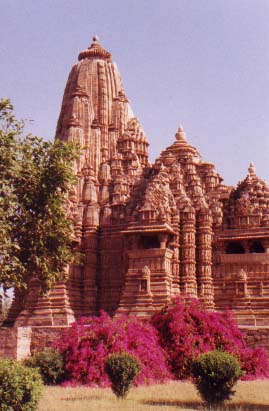 of the temples on the common platform at the back of the
western enclosure is not only the largest; it is also artistically and
architecturally the most perfect. Built 1025-50, it represents Chandela
art at it finest. Although the four main temples are long gone, the
central shrine is in superb condition and shows the typical fire-part
design of Khajuraho temples. of the temples on the common platform at the back of the
western enclosure is not only the largest; it is also artistically and
architecturally the most perfect. Built 1025-50, it represents Chandela
art at it finest. Although the four main temples are long gone, the
central shrine is in superb condition and shows the typical fire-part
design of Khajuraho temples.
The main spire is 31m high, and the temple is lavishly
carved. The English archaeologist Cunningham counted 226 statues inside
the temple and a further 646 outside –872 in total with most of them
nearly 1m high. The statues are carved around the temple in three bands
and include gods, goddesses, beautiful women, musicians and, of course,
some of the famed erotic groups. The mithuna on the Kandariya Mahadev
include some of the most energetic eroticism to be seen at
Khajuraho.
Mahadeva:
This small and mainly ruined temple stands on the same base as the
Kandariya Mahadev and the Devi Jagadamba. Although small and insignificant
compared to its mighty neighbours, it houses one of Khajuraho’s best
sculptures- a fine sardula figure caressing a lion.
Devi Jagadamba
The third temple on the common platform is slightly older
than the
![]() Kandariya Mahadev and of a simpler, three-part design. It was
probably originally dedicated to Vishnu, but later dedicated to Parvati
and then Kali. Some students believe it may still be a Parvati temple and
that the Kali image (or Jagadamba) is actually an image of parvati,
painted black. The sculptures around the temple are again in three bands.
Many of the two lower band images are of Vishnu with sardulas in the inner
recesses. But on the third and uppermost band the mithuna again comes out
to play. Kandariya Mahadev and of a simpler, three-part design. It was
probably originally dedicated to Vishnu, but later dedicated to Parvati
and then Kali. Some students believe it may still be a Parvati temple and
that the Kali image (or Jagadamba) is actually an image of parvati,
painted black. The sculptures around the temple are again in three bands.
Many of the two lower band images are of Vishnu with sardulas in the inner
recesses. But on the third and uppermost band the mithuna again comes out
to play.
Chitragupta
The fourth temple at the back of the western enclosure does
not share the common platform with the other three. Similar in design to
the Devi Jagadamba, this temple is probably slightly newer and is unique
at Khajuraho in being dedicated to Surya, the sun god.
Attempts have obviously been made at restoration, but it is
not in as good condition as other temples. Nevertheless it has some very
fine sculptures, which include processions, dancing girls, elephant fights
and hunting scenes. In the inner sanctum, Surya can be seen driving his
chariot and seven horses, while on the central niche in the south façade
you can seen an 11-headed statues of Vishnu. The central head is that of
Vishnu himself; the 10 others are of his incarnations.
Parvati:
Continuing around the enclosure, you come to the Parvati Temple on
your right. The name is probably incorrect since this small and not so
interesting temple was originally dedicated to Vishnu and now has an image
of Ganga riding on the back of a crocodile.
Vishvanath & Nandi
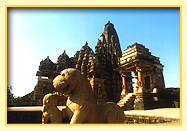 Believed to have been built in 1002, this temple has the complete five
–part design of the larger Kandariya Mahadev Temple, but tow of its four
subsidiary shrines still stand. The large image of Shiva’s vehicle, the
bull Nandi, faces the temple from the other end of the common platform.
Steps lead up to this high terrace, flanked by lions on the northern side
and elephants on the southern side. Believed to have been built in 1002, this temple has the complete five
–part design of the larger Kandariya Mahadev Temple, but tow of its four
subsidiary shrines still stand. The large image of Shiva’s vehicle, the
bull Nandi, faces the temple from the other end of the common platform.
Steps lead up to this high terrace, flanked by lions on the northern side
and elephants on the southern side.
![]() The sculptures around the temple include the usual
Khajuraho scenes, but the sculptures or women are particularly notable
here. They a write letters, fondle a baby; play music and, perhaps more so
than at any other temple, languish in provocative poses. The sculptures around the temple include the usual
Khajuraho scenes, but the sculptures or women are particularly notable
here. They a write letters, fondle a baby; play music and, perhaps more so
than at any other temple, languish in provocative poses.
Matangesvara
Standing next to the Lakshmana Temple, this temple is not within the
fenced enclosure because it is still in everyday use, unlike all the other
old Khajuraho temples. It may be the plainest temple here, but inside it
sports a polished lingam, 2.5m high.
Early in the morning, flower-sellers do a brisk
trade in garlands for the statue of Ganesh outside. People drape them
round the elephant-headed statue, say a prayer and as they walk away the
sellers whip the flowers off the resell!
Chausath Yogini & Lalguan Mahadev
Standing beyond the tank, some distance from the other western group
temples, this ruined temple is probably the oldest at Khajuraho, dating
from 900 AD or earlier. It is also the only temple constructed entirely of
granite and the only one not aligned east to west. Chausath means 64-the
temple once had 64 cells for figures of the 64 yoginis who attended the
goddess Kali. A 65the cell sheltered Kali herself.
A farther 500m west is the Lalguan Mahadev
Temple, a small, ruined shrine dedicated to Shiva and constructed of
granite and sandstone.
Eastern Group
![]() The eastern group of temples can be subdivided into two groups. The
first is made up of interesting Jain temples in the walled enclosure. The
other four temples are scattered through the old village of Khajuraho (as
distinct from the modern village near the western temples). The eastern group of temples can be subdivided into two groups. The
first is made up of interesting Jain temples in the walled enclosure. The
other four temples are scattered through the old village of Khajuraho (as
distinct from the modern village near the western temples).
Parsvanath
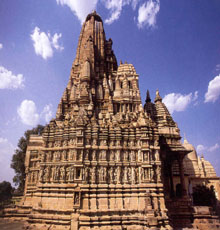 The largest of the Jain temple in the walled enclosure is also one of
the finest at Khajuraho. Although it does not approach the western
enclosure temples in size, and does not attempt to compete in the sexual
activity stakes, it is notable for the exceptional skill and precision of
its construction, and for the beauty of its sculptures. Some of the best
known figures at Khajuraho can be seen here, including the classic figure
of a women removing a thorn from her foot and another of a women applying
eye make-up . Although it was originally dedicated to Adinath, an image of
Parsvanath was substituted about a century ago; the temple takes its name
from this newer image. The largest of the Jain temple in the walled enclosure is also one of
the finest at Khajuraho. Although it does not approach the western
enclosure temples in size, and does not attempt to compete in the sexual
activity stakes, it is notable for the exceptional skill and precision of
its construction, and for the beauty of its sculptures. Some of the best
known figures at Khajuraho can be seen here, including the classic figure
of a women removing a thorn from her foot and another of a women applying
eye make-up . Although it was originally dedicated to Adinath, an image of
Parsvanath was substituted about a century ago; the temple takes its name
from this newer image.
Adinath
 Adjacent to the Parsvanath Temple, the smaller Adinath has been
partially restored over the centuries. It has fine carvings on its three
bands of sculptures and, like the Parsvanath, is very similar to the Hindu
temples of Khajuraho. Only the striking black image in the inner sanctum
indicates that it is Jain rather than Hindu. Adjacent to the Parsvanath Temple, the smaller Adinath has been
partially restored over the centuries. It has fine carvings on its three
bands of sculptures and, like the Parsvanath, is very similar to the Hindu
temples of Khajuraho. Only the striking black image in the inner sanctum
indicates that it is Jain rather than Hindu.
Shanti Nath
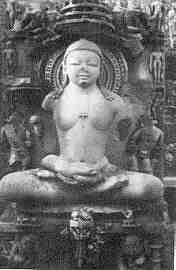 This temple is a relatively modern one built about a century ago, but
it contains many components from older temple around Khajuraho. The 4.5m
–high statue of Adinath is said to have been sculpted in 1028. Groups of
Digambara (Sky-clad, or naked) Jain pilgrims occasionally stay at the dharamsala
(pilgrims’ lodging) here. This temple is a relatively modern one built about a century ago, but
it contains many components from older temple around Khajuraho. The 4.5m
–high statue of Adinath is said to have been sculpted in 1028. Groups of
Digambara (Sky-clad, or naked) Jain pilgrims occasionally stay at the dharamsala
(pilgrims’ lodging) here.
Ghantai
Walking from the eastern Jain temple group towards Khajuraho village,
you come to this small, ruined Jain temple. Only its pillared small
remains, but it is interesting for the delicate columns with their
bell-and –chain decoration and for the figure of a Jain goddess astride
a Garuda that marks the entrance.
Javari
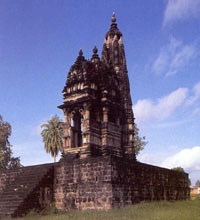 Walk through the village, a typical small Indian settlement, to this
temple. Dating from around 1075 to 1100 AD, it is dedicated to Vishnu and
is a particularly fine example of Khajuraho architecture on a small scale.
The exterior has more of Khajuraho’s maidens. Walk through the village, a typical small Indian settlement, to this
temple. Dating from around 1075 to 1100 AD, it is dedicated to Vishnu and
is a particularly fine example of Khajuraho architecture on a small scale.
The exterior has more of Khajuraho’s maidens.
Vamana
About 200m north of the Javari Temple, this temple is dedicated to
Vamana, the dwarf incarnation of Vishnu. Slightly older than the Javari
Temple, the Vamana, Temple stands out in a field all by itself. It’s
notable for the relatively simple design of its sikhara. The bands of
sculpture around the temple are, as usual, very fine with numerous
celestial maidens adopting interesting poses.
Brahma & Hanuman
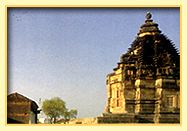 Turning back (west) towards the modern village, you pass a granite and
sandstone temple, one of the oldest at Khajuraho. It was actually
dedicated to Vishnu and the definition of it as a Brahma temple is
incorrect. Turning back (west) towards the modern village, you pass a granite and
sandstone temple, one of the oldest at Khajuraho. It was actually
dedicated to Vishnu and the definition of it as a Brahma temple is
incorrect.
Taking the road
directly from the modern village to the Jain enclosure, you pass a Hanuman
Temple containing a large image of the monkey god. This 2.5m statue has on
it the oldest inscription here-922 AD.
Duladeo
![]() A dirt track runs to this isolated temple, about 1km south of the Jain
enclosure. This is a later temple, and experts say that at this time the
skill of Khajuraho’s temple builders had passed its peak and the
sculptures are more ’wooden’ and ‘stereotyped’ than on earlier
temples. Nevertheless, it’s fine and graceful temple with figures of
women in a variety of pin-up poses and a number of mithuna couples. A dirt track runs to this isolated temple, about 1km south of the Jain
enclosure. This is a later temple, and experts say that at this time the
skill of Khajuraho’s temple builders had passed its peak and the
sculptures are more ’wooden’ and ‘stereotyped’ than on earlier
temples. Nevertheless, it’s fine and graceful temple with figures of
women in a variety of pin-up poses and a number of mithuna couples.
Chaturbhuja
 South of the river, about 3km from the village and a healthy hike down
a dirt road, this ruined temple has a fine 3km high image of Vishnu. South of the river, about 3km from the village and a healthy hike down
a dirt road, this ruined temple has a fine 3km high image of Vishnu.
Special Events
The Khjuraho Festival of Dance is a week-long event held every year in
February/ March. It attracts the cream of Indian classical dancers who
perform amid the temples in the western enclosure. In 2000 the festival
will take place from 2 to 8 March, marking the end of Khajuraho’s year
–long millennium celebrations. Performances are open-air, with the
floodlit temples as a backdrop.
Places
to Stay
HOTEL CHANDELA (5 Star Deluxe),
JASS TRIDENT (5 Star),
HOTEL CLARKS KHAJURAHO (3 Star)
KHAJURAHO ASHOK (3 Star)
USHA BUNDELA (3 Star)
|





